Spatiotemporal Variation and Development Stage of CO2 Emissions of Urban Agglomerations in the Yangtze River Economic Belt, China
Abstract
:1. Introduction
2. Datasets and Methods
2.1. Study Area
2.2. Datasets
2.2.1. CO2 Emissions Data
2.2.2. Socio-Economic Data
2.3. Spatial Autocorrelation
2.3.1. Global Autocorrelation
2.3.2. Local Autocorrelation
2.4. Carbon Emission Development Stage
2.4.1. Environmental Kuznets Curve (EKC)
2.4.2. Carbon Emission Development Stage Division Based on EKCs
2.5. MGWR Model
3. Results
3.1. Spatiotemporal Variation of CO2 Emissions
3.1.1. Temporal Variation of CO2 Emissions
3.1.2. Spatial Variation of CO2 Emissions
3.1.3. Spatial Aggregation of CO2 Emissions
3.2. Carbon Emission Development Stage Analysis
3.3. Model Comparison
3.3.1. Comparison of Model Performance
3.3.2. Comparison of Model Bandwidth
3.4. Influencing Factors for CO2 Emissions
4. Discussion
4.1. Insights into the CO2 Emissions of YREB Urban Agglomerations
4.2. Limitations
5. Conclusions
- (1)
- The CO2 emissions in the three urban agglomerations first increased and then decreased from 2008 to 2017. YRD-UA contributed 41.87% of the CO2 emissions of YREB, with the highest CO2 emissions among the three urban agglomerations. A symposium on comprehensively advancing the development of the sustainable development of YREB was held in 2016, and the CO2 emissions in three urban agglomerations decreased significantly in 2017.
- (2)
- The carbon emission development stage of urban agglomeration was analyzed based on the relationship between carbon emissions and economic growth. According to the EKCs, CY-UA, YRMR-UA, and YRD-UA reached the CO2 emissions peaks around 2012, 2011, and 2020, respectively. Nowadays, the urban agglomerations in YREB are at the low-carbon stage.
- (3)
- The CO2 emissions of YREB urban agglomerations were significantly affected by POP and GDPPC, while the impacts of UR and SI were not significant. The spatial distribution of influencing factors changed significantly in 2017. To reduce CO2 emissions, human capital agglomeration and clean energy should be considered in the process of urbanization.
Author Contributions
Funding
Data Availability Statement
Acknowledgments
Conflicts of Interest
References
- Clark, P.U.; Shakun, J.D.; Marcott, S.A.; Mix, A.C.; Eby, M.; Kulp, S.; Levermann, A.; Milne, G.A.; Pfister, P.L.; Santer, B.D.; et al. Consequences of twenty-first-century policy for multi-millennial climate and sea-level change. Nat. Clim. Change 2016, 6, 360–369. [Google Scholar] [CrossRef]
- Wang, S.; Wang, J.; Li, S.; Fang, C.; Feng, K. Socioeconomic driving forces and scenario simulation of CO2 emissions for a fast-developing region in China. J. Clean. Prod. 2019, 216, 217–229. [Google Scholar] [CrossRef]
- Lindsey, R.; Dahlman, L. Climate Change: Global Temperature. 2020. Available online: https://www.climate.gov/news-features/understanding-climate/climate-change-global-temperature (accessed on 1 January 2023).
- Frame, D.J.; Held, H.; Kriegler, E.; Mach, K.J.; Matschoss, P.R.; Plattner, G.-K.; Zwiers, F.W.; Matschoss, P.R. Guidance Note for Lead Authors of the IPCC Fifth Assessment Report on Consistent Treatment of Uncertainties. Intergovernmental Panel on Climate Change (IPCC). Available online: http://www.ipcc.ch (accessed on 30 March 2023).
- Qian, Y.; Wang, H.; Wu, J. Spatiotemporal association of carbon dioxide emissions in China’s urban agglomerations. J. Environ. Manage. 2022, 323, 116109. [Google Scholar] [CrossRef]
- Wang, F.; Harindintwali, J.D.; Yuan, Z.; Wang, M.; Wang, F.; Li, S.; Yin, Z.; Huang, L.; Fu, Y.; Li, L.; et al. Technologies and perspectives for achieving carbon neutrality. Innovation 2021, 2, 100180. [Google Scholar] [CrossRef] [PubMed]
- Dong, F.; Li, Y.; Gao, Y.; Zhu, J.; Qin, C.; Zhang, X. Energy transition and carbon neutrality: Exploring the non-linear impact of renewable energy development on carbon emission efficiency in developed countries. Resour. Conserv. Recycl. 2022, 177, 106002. [Google Scholar] [CrossRef]
- Xiao, Y.; Ma, D.; Zhang, F.; Zhao, N.; Wang, L.; Guo, Z.; Zhang, J.; An, B.; Xiao, Y. Spatiotemporal differentiation of carbon emission efficiency and influencing factors: From the perspective of 136 countries. Sci. Total Environ. 2023, 879, 163032. [Google Scholar] [CrossRef]
- Andreoni, V.; Galmarini, S. Drivers in CO2 emissions variation: A decomposition analysis for 33 world countries. Energy 2016, 103, 27–37. [Google Scholar] [CrossRef]
- Grodzicki, T.; Jankiewicz, M. The impact of renewable energy and urbanization on CO2 emissions in Europe—Spatio-temporal approach. Environ. Dev. 2022, 44, 100755. [Google Scholar] [CrossRef]
- Namahoro, J.; Wu, Q.; Zhou, N.; Xue, S. Impact of energy intensity, renewable energy, and economic growth on CO2 emissions: Evidence from Africa across regions and income levels. Renew. Sustain. Energy Rev. 2021, 147, 111233. [Google Scholar] [CrossRef]
- Fragkias, M.; Lobo, J.; Strumsky, D.; Seto, K.C. Does size matter? Scaling of CO2 emissions and US urban areas. PLoS ONE 2013, 8, e64727. [Google Scholar] [CrossRef]
- Wen, L.; Shao, H. Analysis of influencing factors of the CO2 emissions in China: Nonparametric additive regression approach. Sci. Total Environ. 2019, 694, 133724. [Google Scholar] [CrossRef]
- Liu, Z.; Deng, Z.; He, G.; Wang, H.; Zhang, X.; Lin, J.; Qi, Y.; Liang, X. Challenges and opportunities for carbon neutrality in China. Nat. Rev. Earth Environ. 2021, 3, 141–155. [Google Scholar] [CrossRef]
- Zeng, N.; Jiang, K.; Han, P.; Hausfather, Z.; Cao, J.; Kirk-Davidoff, D.; Ali, S.; Zhou, S. The Chinese carbon-neutral goal: Challenges and prospects. Adv. Atmos. Sci. 2022, 39, 1229–1238. [Google Scholar] [CrossRef] [PubMed]
- Wang, K.; Zhang, X.; Wei, Y.-M.; Yu, S. Regional allocation of CO2 emissions allowance over provinces in China by 2020. Energy Policy 2013, 54, 214–229. [Google Scholar] [CrossRef]
- Liu, J.; Tian, Y.; Huang, K.; Yi, T. Spatial-temporal differentiation of the coupling coordinated development of regional energy-economy-ecology system: A case study of the Yangtze River Economic Belt. Ecol. Indic. 2021, 124, 107394. [Google Scholar] [CrossRef]
- Yuan, L.; Li, R.; Wu, X.; He, W.; Kong, Y.; Ramsey, T.S.; Degefu, D.M. Decoupling of economic growth and resources-environmental pressure in the Yangtze River Economic Belt, China. Ecol. Indic. 2023, 153, 110399. [Google Scholar] [CrossRef]
- Liu, Q.; Hao, J. Regional Differences and Influencing Factors of Carbon Emission Efficiency in the Yangtze River Economic Belt. Sustainability 2022, 14, 4814. [Google Scholar] [CrossRef]
- Li, K.; Zhou, Y.; Xiao, H.; Li, Z.; Shan, Y. Decoupling of economic growth from CO2 emissions in Yangtze River Economic Belt cities. Sci. Total Environ. 2021, 775, 145927. [Google Scholar] [CrossRef]
- Fang, C.; Yu, D. Urban agglomeration: An evolving concept of an emerging phenomenon. Landsc. Urban Plan. 2017, 162, 126–136. [Google Scholar] [CrossRef]
- Li, L.; Ma, S.; Zheng, Y.; Xiao, X. Integrated regional development: Comparison of urban agglomeration policies in China. Land Use Policy 2022, 114, 105939. [Google Scholar] [CrossRef]
- Yu, X.; Wu, Z.; Zheng, H.; Li, M.; Tan, T. How urban agglomeration improve the emission efficiency? A spatial econometric analysis of the Yangtze River Delta urban agglomeration in China. J. Environ. Manage. 2020, 260, 110061. [Google Scholar] [CrossRef] [PubMed]
- Tan, J.; Wang, R. Research on evaluation and influencing factors of regional ecological efficiency from the perspective of carbon neutrality. J. Environ. Manage. 2021, 294, 113030. [Google Scholar] [CrossRef] [PubMed]
- Rao, G.; Liao, J.; Zhu, Y.; Guo, L. Decoupling of economic growth from CO2 emissions in Yangtze River Economic Belt sectors: A sectoral correlation effects perspective. Appl. Energy 2022, 307, 118223. [Google Scholar] [CrossRef]
- Wang, P.; Wu, J. Impact of environmental investment and resource endowment on regional energy efficiency: Evidence from the Yangtze River Economic Belt, China. Environ. Sci. Pollut. Res. 2022, 29, 5445–5453. [Google Scholar] [CrossRef]
- Chen, Y.; Zhang, S.; Huang, D.; Li, B.-L.; Liu, J.; Liu, W.; Ma, J.; Wang, F.; Wang, Y.; Wu, S.; et al. The development of China’s Yangtze River Economic Belt: How to make it in a green way? Sci. Bull. 2017, 62, 648–651. [Google Scholar] [CrossRef] [PubMed]
- Li, M.; Liu, H.; Geng, G.; Hong, C.; Liu, F.; Song, Y.; Tong, D.; Zheng, B.; Cui, H.; Man, H.; et al. Anthropogenic emission inventories in China: A review. Natl. Sci. Rev. 2017, 4, 834–866. [Google Scholar] [CrossRef]
- Zheng, B.; Tong, D.; Li, M.; Liu, F.; Hong, C.; Geng, G.; Li, H.; Li, X.; Peng, L.; Qi, J.; et al. Trends in China’s anthropogenic emissions since 2010 as the consequence of clean air actions. Atmos. Chem. Phys. 2018, 18, 14095–14111. [Google Scholar] [CrossRef]
- Liu, F.; Zhang, Q.; Tong, D.; Zheng, B.; Li, M.; Huo, H.; He, K.B. High-resolution inventory of technologies, activities, and emissions of coal-fired power plants in China from 1990 to 2010. Atmos. Chem. Phys. 2015, 15, 13299–13317. [Google Scholar] [CrossRef]
- Liu, Q.; Wu, S.; Lei, Y.; Li, S.; Li, L. Exploring spatial characteristics of city-level CO2 emissions in China and their influencing factors from global and local perspectives. Sci. Total Environ. 2021, 754, 142206. [Google Scholar] [CrossRef]
- Cui, E.; Ren, L.; Sun, H. Analysis on the regional difference and impact factors of CO2 emissions in China. Environ. Prog. Sustain. Energy 2017, 36, 1282–1289. [Google Scholar] [CrossRef]
- Zhao, Y.; Chen, R.; Sun, T.; Yang, Y.; Ma, S.; Xie, D.; Zhang, X.; Cai, Y. Urbanization Influences CO2 Emissions in the Pearl River Delta: A Perspective of the “Space of Flows”. Land 2022, 11, 1373. [Google Scholar] [CrossRef]
- Liu, Y.; Zhang, X.; Pan, X.; Ma, X.; Tang, M. The spatial integration and coordinated industrial development of urban agglomerations in the Yangtze River Economic Belt, China. Cities 2020, 104, 102801. [Google Scholar] [CrossRef]
- Dong, L.; Liang, H. Spatial analysis on China’s regional air pollutants and CO2 emissions: Emission pattern and regional disparity. Atmos. Environ. 2014, 92, 280–291. [Google Scholar] [CrossRef]
- Anselin, L. Local Indicators of Spatial Association-LISA. Geogr. Anal. 2010, 27, 93–115. [Google Scholar] [CrossRef]
- Stern, D.I. The Rise and Fall of the Environmental Kuznets Curve. World Dev. 2004, 32, 1419–1439. [Google Scholar] [CrossRef]
- Carson, R.T. The Environmental Kuznets Curve: Seeking Empirical Regularity and Theoretical Structure. Rev. Environ. Econ. Policy 2010, 4, 3–23. [Google Scholar] [CrossRef]
- Shen, L.; Wu, Y.; Lou, Y.; Zeng, D.; Shuai, C.; Song, X. What drives the carbon emission in the Chinese cities?—A case of pilot low carbon city of Beijing. J. Clean. Prod. 2018, 174, 343–354. [Google Scholar] [CrossRef]
- Brunsdon, C.; Fotheringham, A.S.; Charlton, M.E. Geographically Weighted Regression: A Method for Exploring Spatial Nonstationarity. Geogr. Anal. 2010, 28, 281–298. [Google Scholar] [CrossRef]
- Mansour, S.; Al Kindi, A.; Al-Said, A.; Al-Said, A.; Atkinson, P. Sociodemographic determinants of COVID-19 incidence rates in Oman: Geospatial modelling using multiscale geographically weighted regression (MGWR). Sustain. Cities Soc. 2021, 65, 102627. [Google Scholar] [CrossRef]
- Fotheringham, A.S.; Yang, W.; Kang, W. Multiscale Geographically Weighted Regression (MGWR). Ann. Am. Assoc. Geogr. 2017, 107, 1247–1265. [Google Scholar] [CrossRef]
- Wu, J.; Sun, W. Regional Integration and Sustainable Development in the Yangtze River Delta, China: Towards a Conceptual Framework and Research Agenda. Land 2023, 12, 470. [Google Scholar] [CrossRef]
- Shen, W.; Liang, H.; Dong, L.; Ren, J.; Wang, G. Synergistic CO2 reduction effects in Chinese urban agglomerations: Perspectives from social network analysis. Sci. Total Environ. 2021, 798, 149352. [Google Scholar] [CrossRef] [PubMed]
- Zhou, B.; Zhou, F.; Zhou, D.; Qiao, J.; Xue, B. Improvement of environmental performance and optimization of industrial structure of the Yangtze River economic belt in China: Going forward together or restraining each other? J. Chin. Gov. 2021, 6, 435–455. [Google Scholar] [CrossRef]
- Greenland, S.; Senn, S.J.; Rothman, K.J.; Carlin, J.B.; Poole, C.; Goodman, S.N.; Altman, D.G. Statistical tests, P values, confidence intervals, and power: A guide to misinterpretations. Eur. J. Epidemiol. 2016, 31, 337–350. [Google Scholar] [CrossRef]
- Bivand, R.; Pebesma, E.J.; Gómez-Rubio, V. Applied Spatial Data Analysis with R; Use R! Springer: New York, NY, USA, 2008; ISBN 978-0-387-78170-9. [Google Scholar]
- Li, Z.; Wang, F.; Kang, T.; Wang, C.; Chen, X.; Miao, Z.; Zhang, L.; Ye, Y.; Zhang, H. Exploring differentiated impacts of socioeconomic factors and urban forms on city-level CO2 emissions in China: Spatial heterogeneity and varying importance levels. Sustain. Cities Soc. 2022, 84, 104028. [Google Scholar] [CrossRef]
- Solarin, S.A.; Al-Mulali, U.; Gan, G.G.G.; Shahbaz, M. The impact of biomass energy consumption on pollution: Evidence from 80 developed and developing countries. Environ. Sci. Pollut. Res. 2018, 25, 22641–22657. [Google Scholar] [CrossRef]
- Wang, L.; Zhao, P. From dispersed to clustered: New trend of spatial restructuring in China’s metropolitan region of Yangtze River Delta. Habitat Int. 2018, 80, 70–80. [Google Scholar] [CrossRef]
- Lu, J.; Li, B.; Li, H.; Al-Barakani, A. Expansion of city scale, traffic modes, traffic congestion, and air pollution. Cities 2021, 108, 102974. [Google Scholar] [CrossRef]
- Wolfson, J.; Frisken, F. Local Response to the Global Challenge: Comparing Local Economic Development Policies in a Regional Context. J. Urban Aff. 2000, 22, 361–384. [Google Scholar] [CrossRef]
- Wang, X.; Song, J.; Duan, H.; Wang, X. Coupling between energy efficiency and industrial structure: An urban agglomeration case. Energy 2021, 234, 121304. [Google Scholar] [CrossRef]
- Andersen, M.S.; Massa, I. Ecological modernization—Origins, dilemmas and future directions. J. Environ. Policy Plan. 2000, 2, 337–345. [Google Scholar] [CrossRef]
- Heidenreich, S.; Spieth, P.; Petschnig, M. Ready, steady, green: Examining the effectiveness of external policies to enhance the adoption of eco-friendly innovations. J. Prod. Innov. Manag. 2017, 34, 343–359. [Google Scholar] [CrossRef]
- Bai, Y.; Deng, X.; Gibson, J.; Zhao, Z.; Xu, H. How does urbanization affect residential CO2 emissions? An analysis on urban agglomerations of China. J. Clean. Prod. 2019, 209, 876–885. [Google Scholar] [CrossRef]
- Yang, Z.; Gao, W.; Han, Q.; Qi, L.; Cui, Y.; Chen, Y. Digitalization and carbon emissions: How does digital city construction affect china’s carbon emission reduction? Sustain. Cities Soc. 2022, 87, 104201. [Google Scholar] [CrossRef]
- Cui, W.; Lin, X.; Wang, D.; Mi, Y. Urban Industrial Carbon Efficiency Measurement and Influencing Factors Analysis in China. Land 2022, 12, 26. [Google Scholar] [CrossRef]
- Tian, P.; Liu, Y.; Li, J.; Pu, R.; Cao, L.; Zhang, H. Spatiotemporal patterns of urban expansion and trade-offs and synergies among ecosystem services in urban agglomerations of China. Ecol. Indic. 2023, 148, 110057. [Google Scholar] [CrossRef]
- Xu, S.-C.; He, Z.-X.; Long, R.-Y. Factors that influence carbon emissions due to energy consumption in China: Decomposition analysis using LMDI. Appl. Energy 2014, 127, 182–193. [Google Scholar] [CrossRef]
- Wei, L.; Wang, Z. Differentiation Analysis on Carbon Emission Efficiency and Its Factors at Different Industrialization Stages: Evidence from Mainland China. Int. J. Environ. Res. Public. Health 2022, 19, 16650. [Google Scholar] [CrossRef]
- Xu, R.; Lin, B. Why are there large regional differences in CO2 emissions? Evidence from China’s manufacturing industry. J. Clean. Prod. 2017, 140, 1330–1343. [Google Scholar] [CrossRef]
- Stern, N.; Xie, C. China’s new growth story: Linking the 14th Five-Year Plan with the 2060 carbon neutrality pledge. J. Chin. Econ. Bus. Stud. 2023, 21, 5–25. [Google Scholar] [CrossRef]
- Gao, C.; Su, B.; Sun, M.; Zhang, X.; Zhang, Z. Interprovincial transfer of embodied primary energy in China: A complex network approach. Appl. Energy 2018, 215, 792–807. [Google Scholar] [CrossRef]
- Zhu, Z.; Yu, J.; Luo, J.; Zhang, H.; Wu, Q.; Chen, Y. A GDM-GTWR-Coupled Model for Spatiotemporal Heterogeneity Quantification of CO2 Emissions: A Case of the Yangtze River Delta Urban Agglomeration from 2000 to 2017. Atmosphere 2022, 13, 1195. [Google Scholar] [CrossRef]
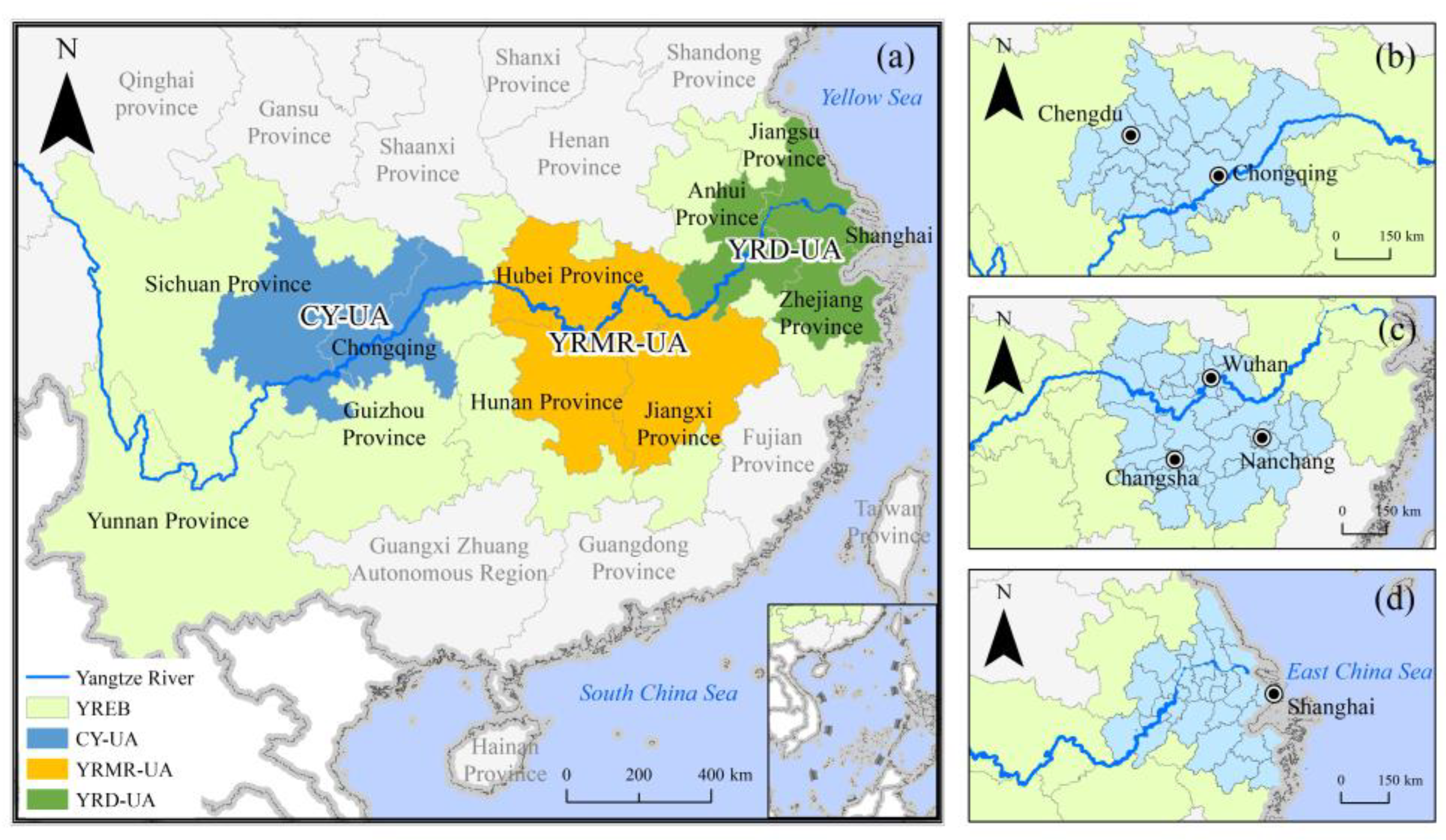
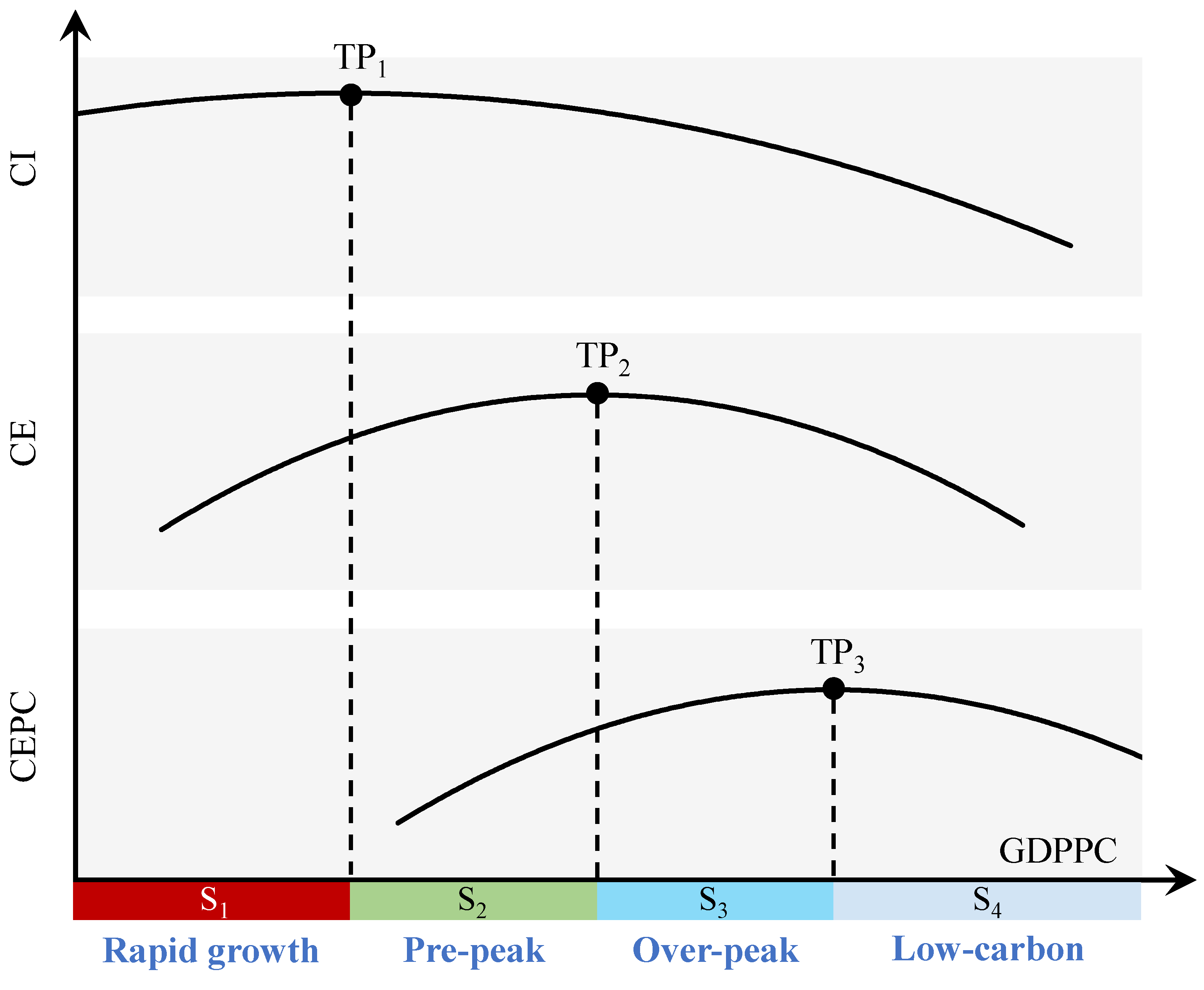
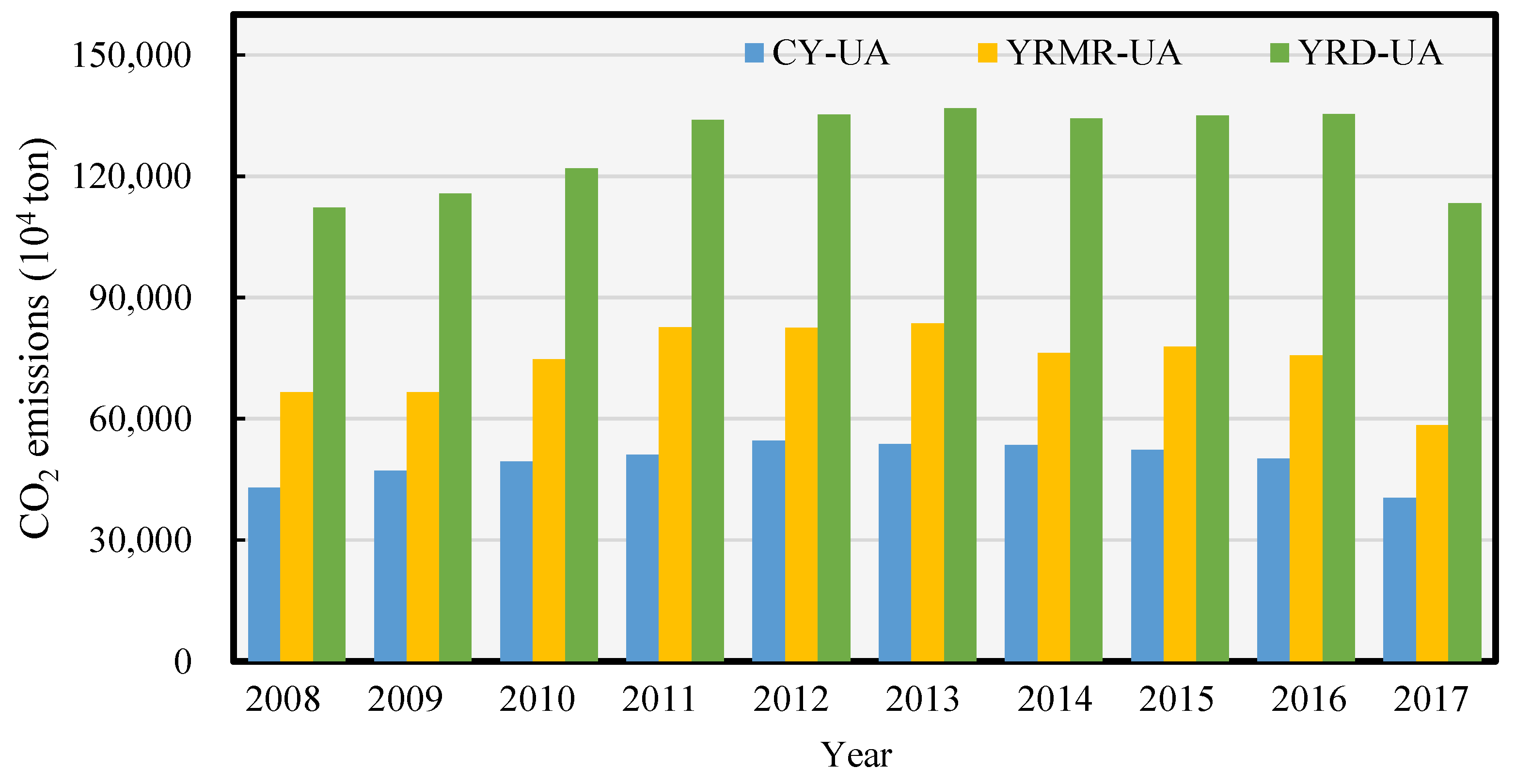
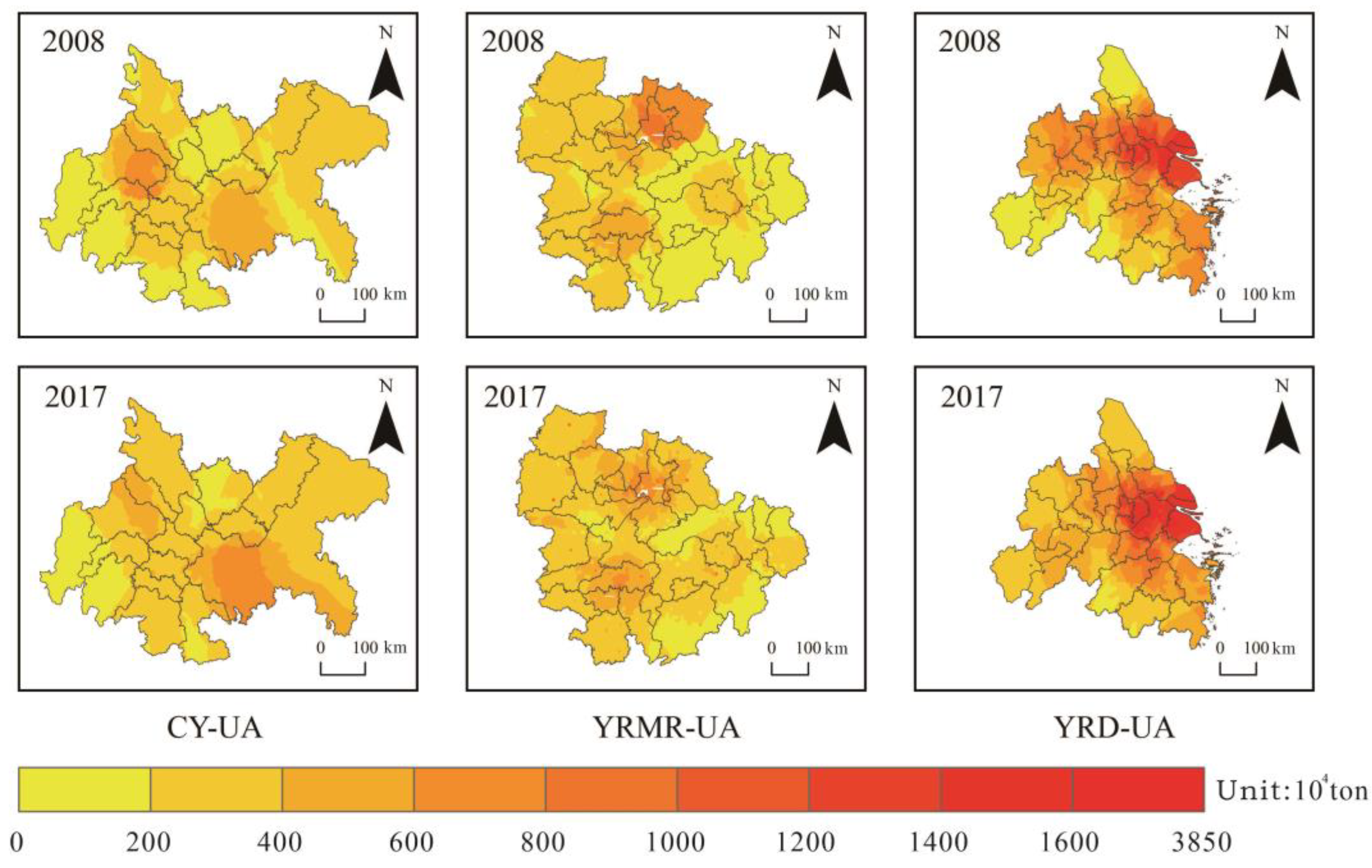
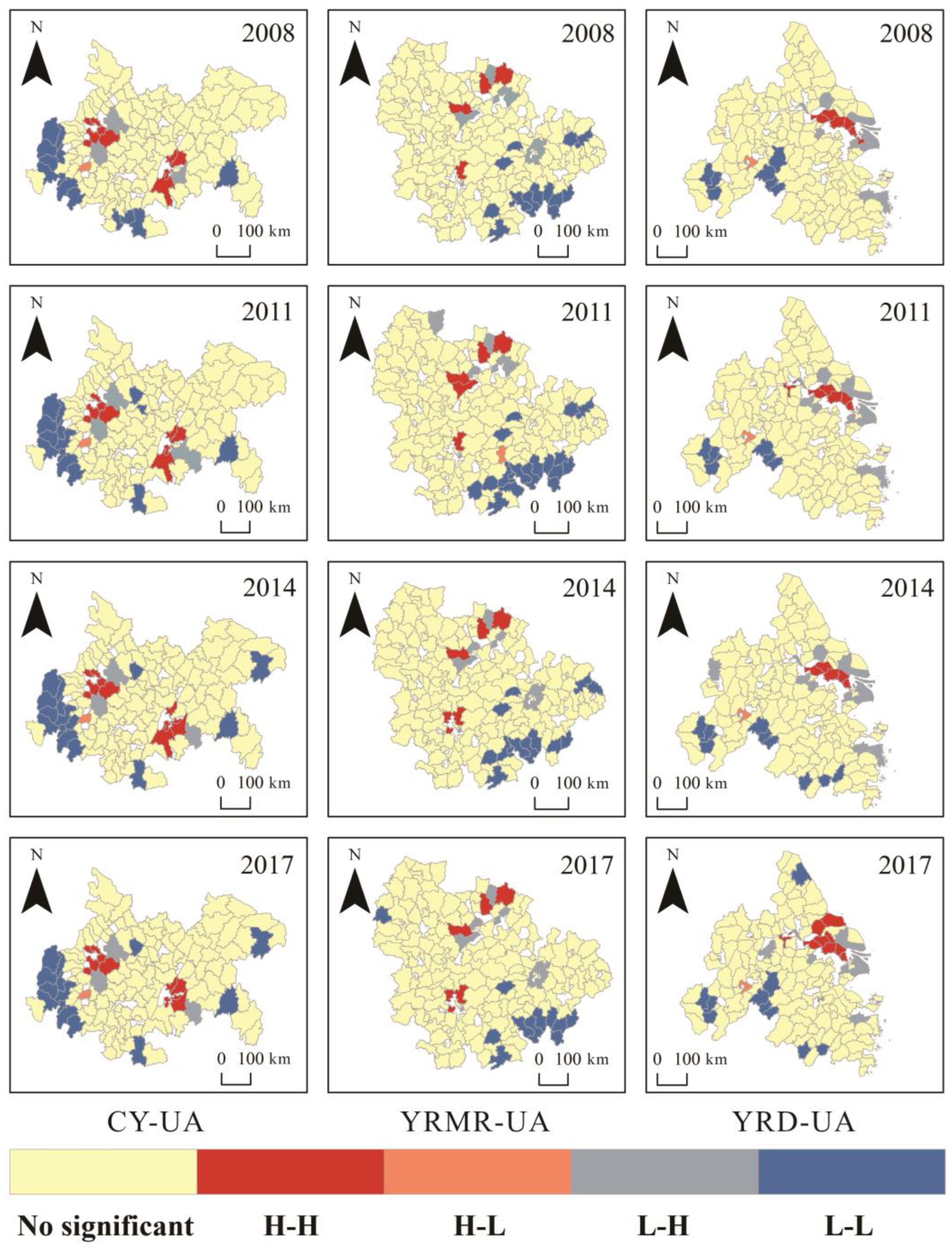
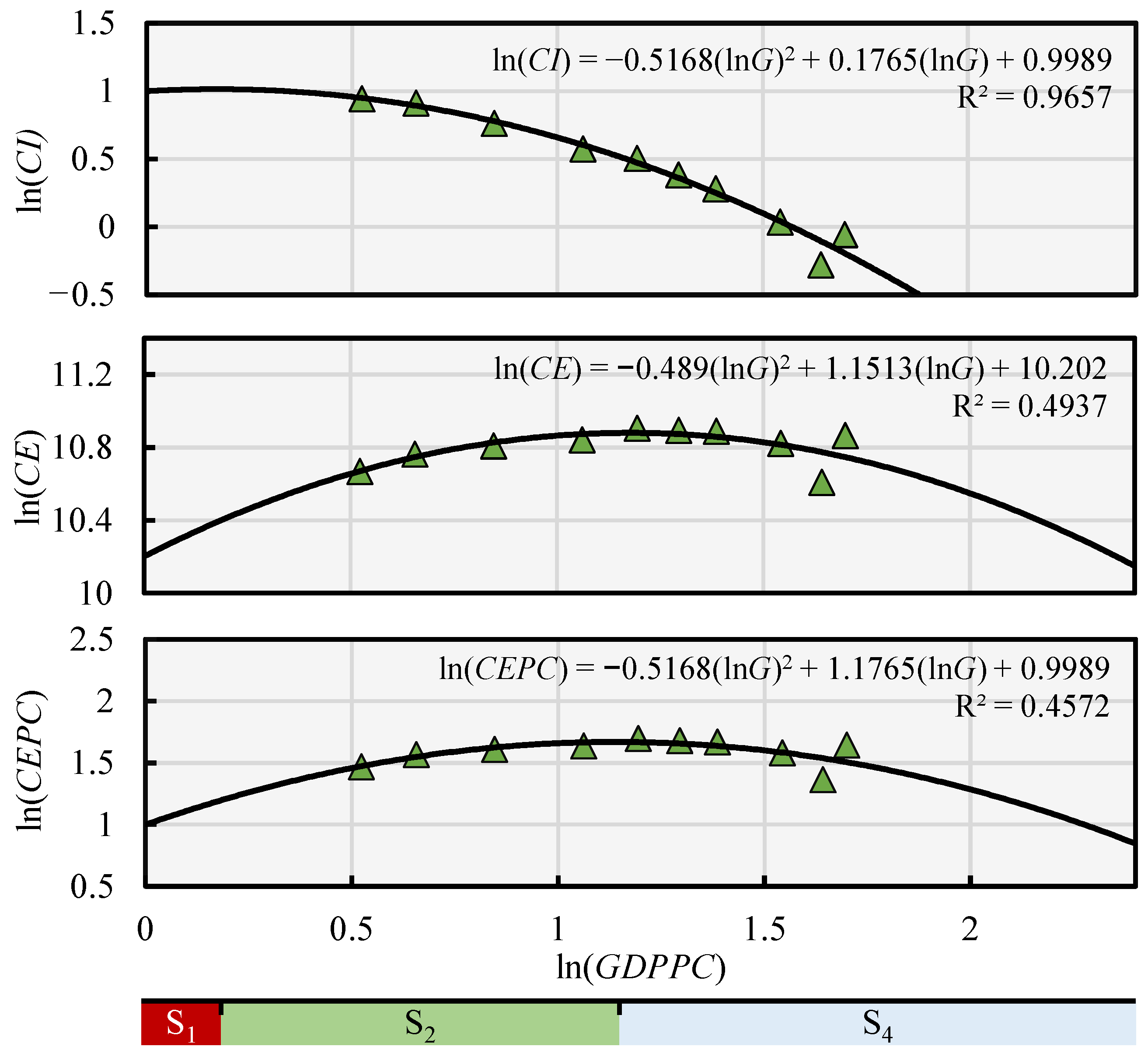
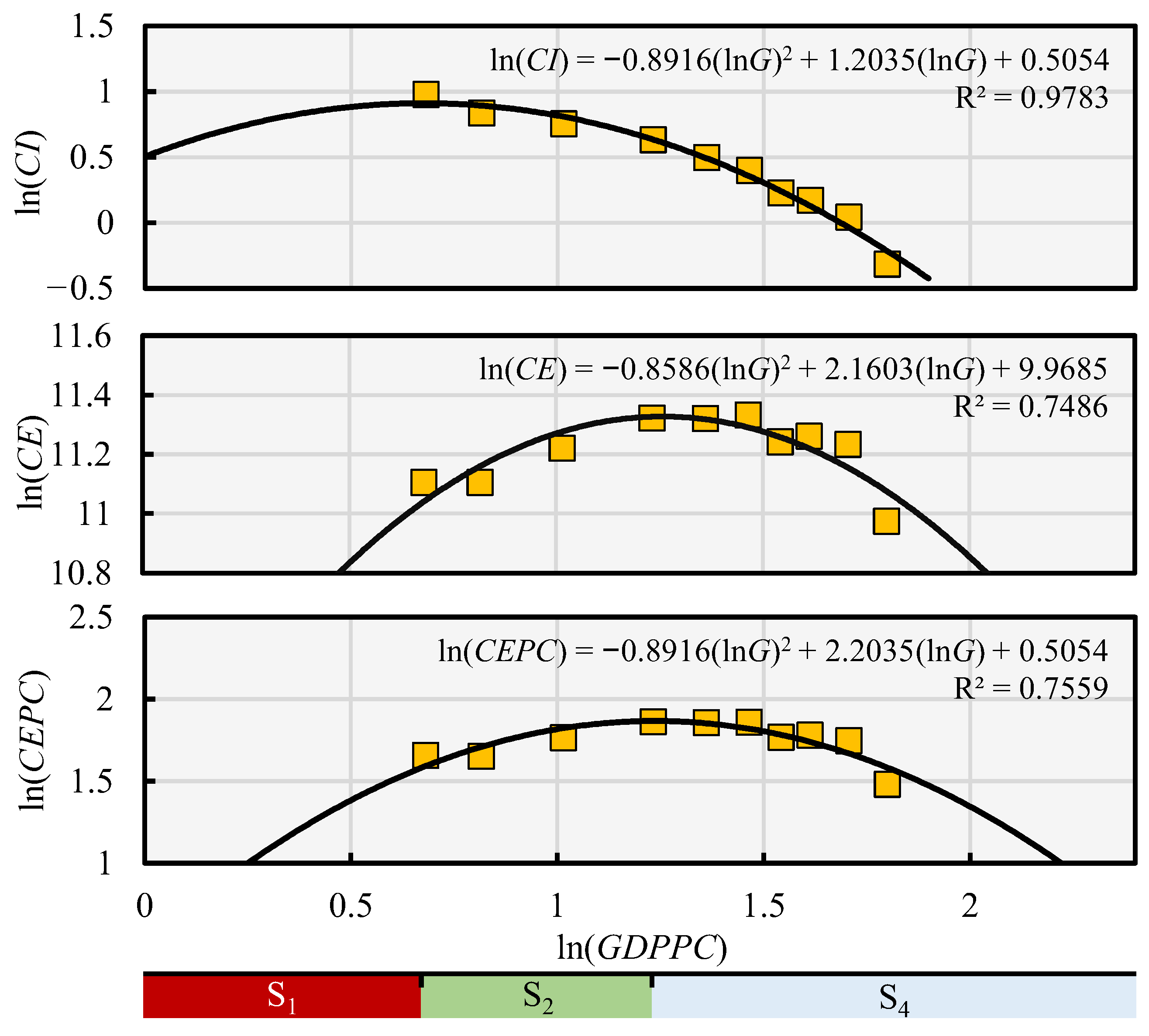
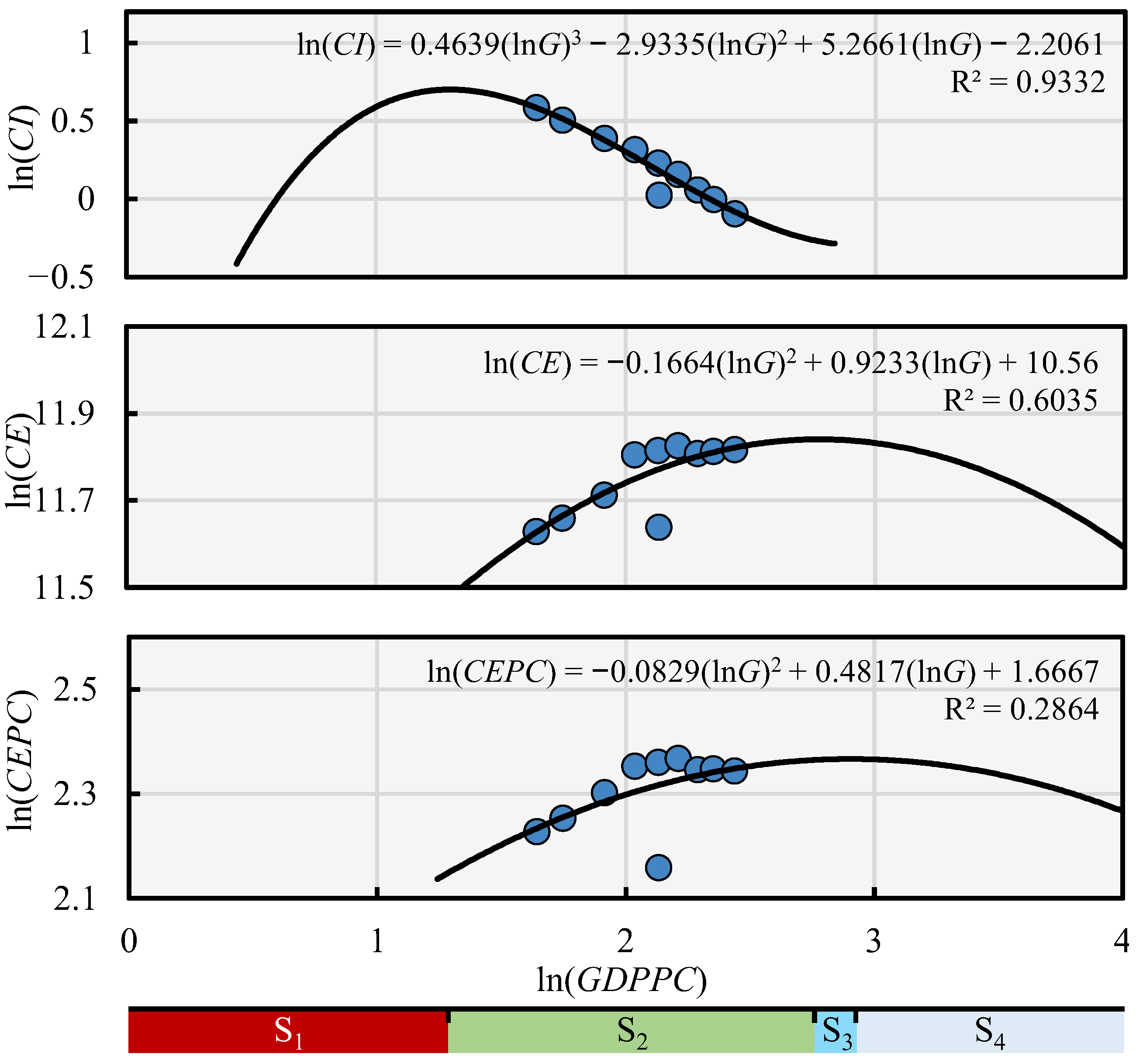
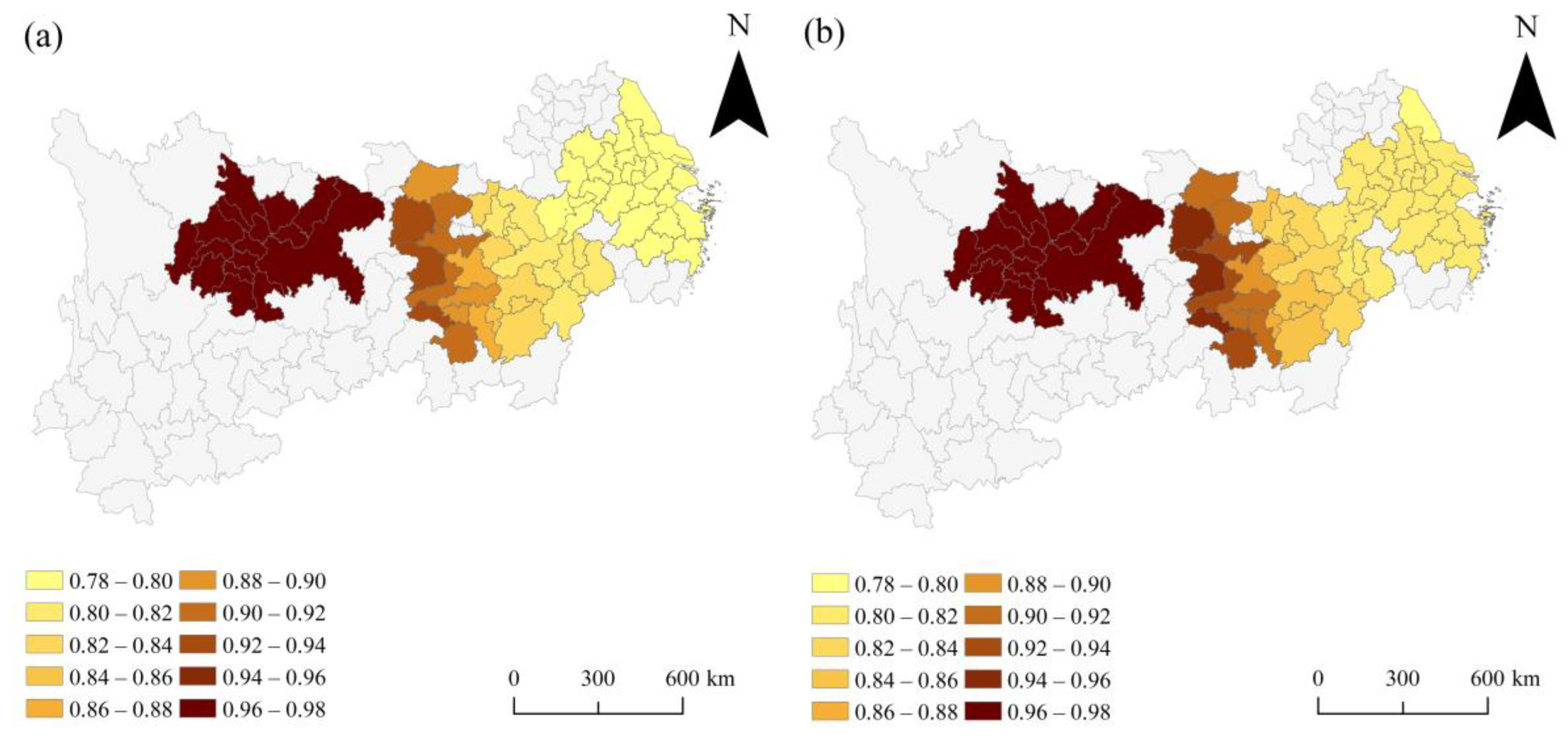
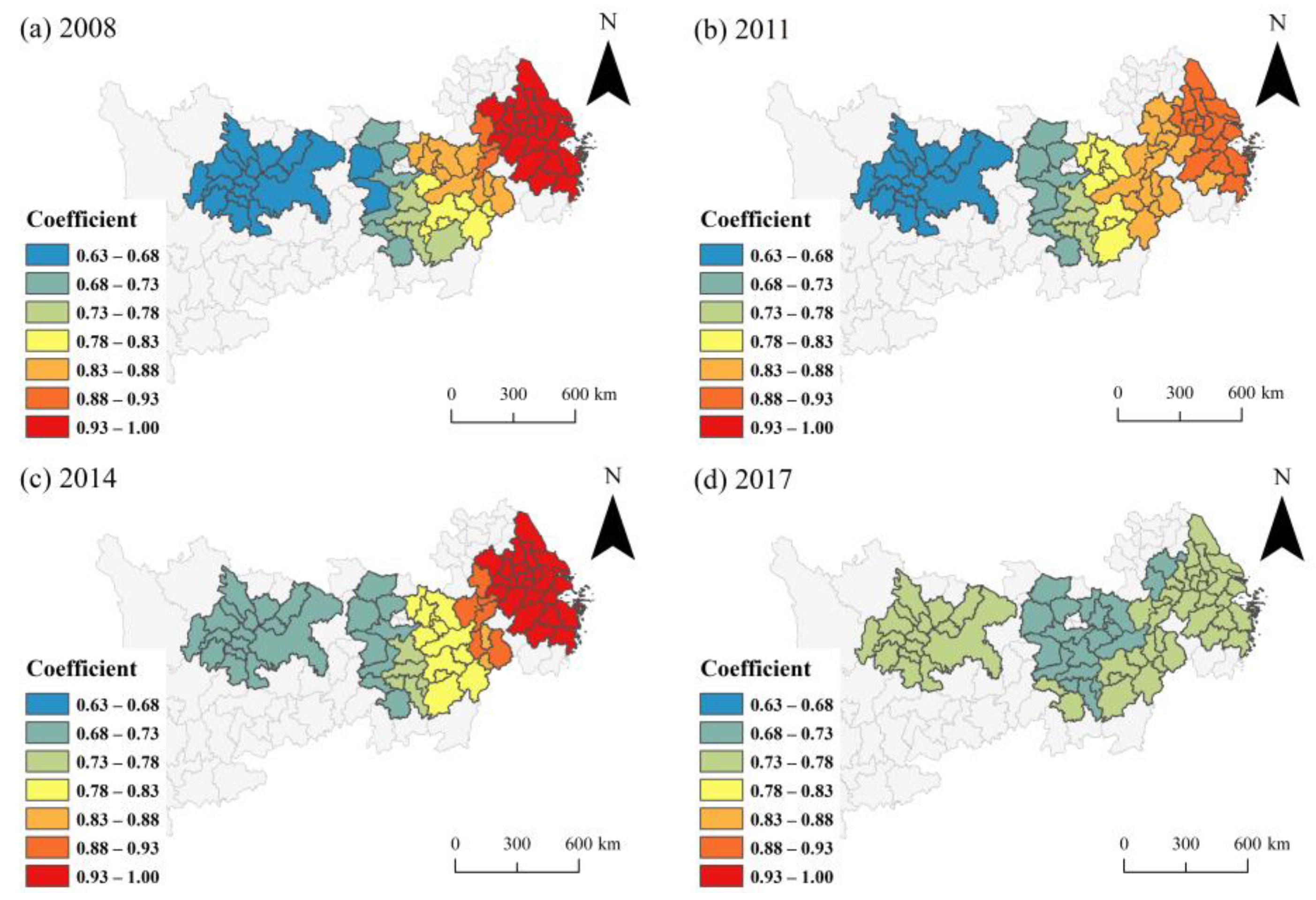
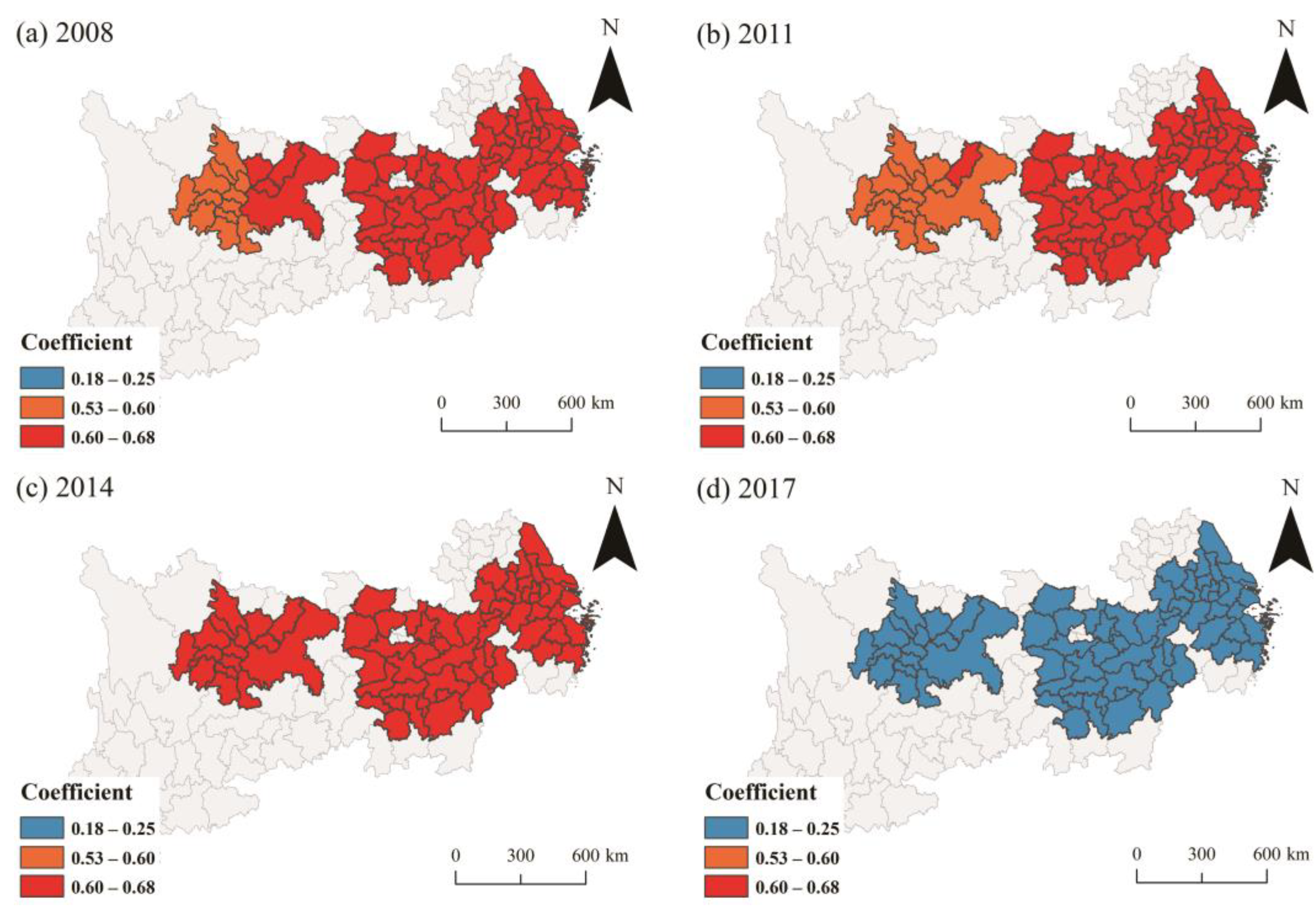
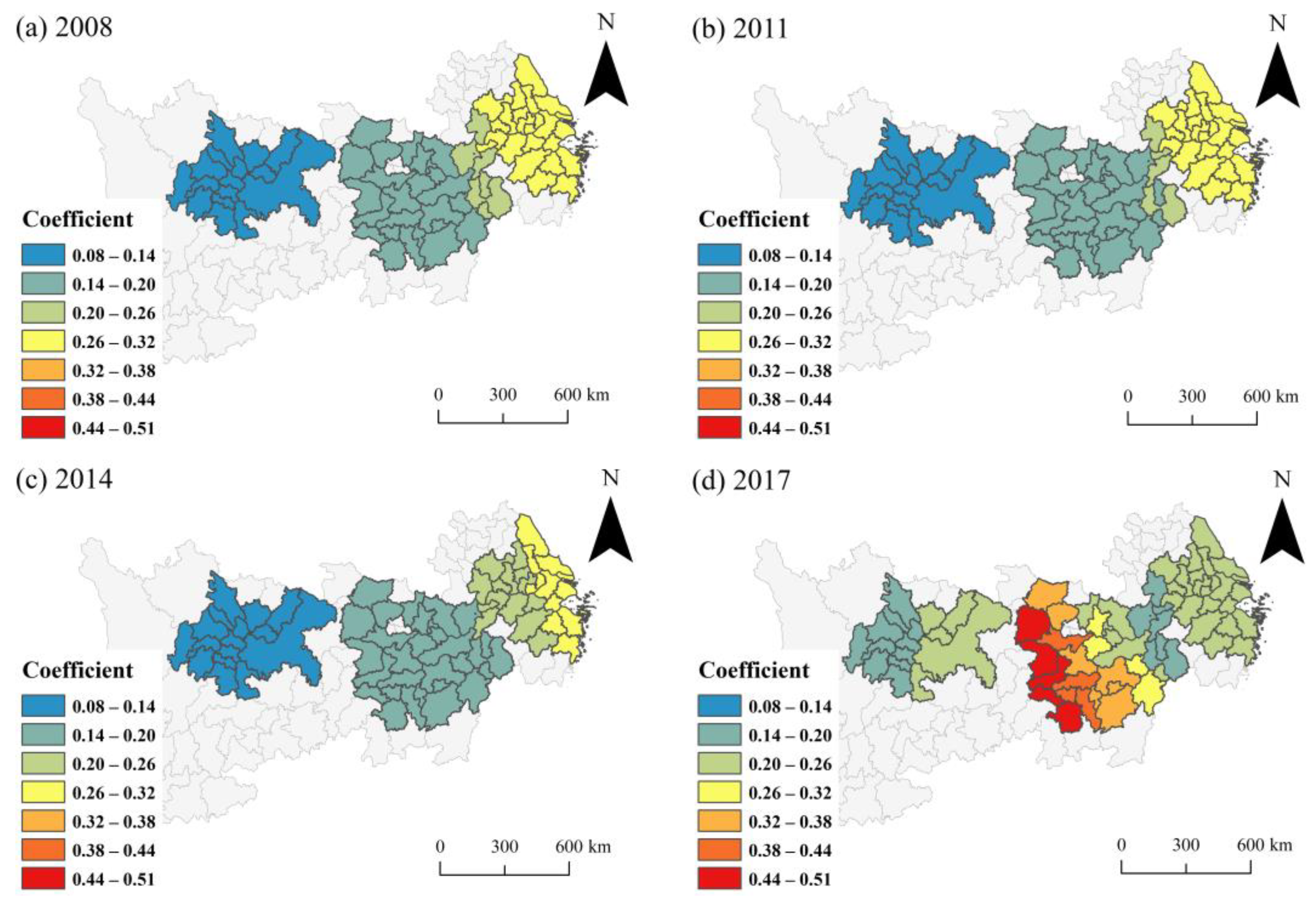


| Cities | |
|---|---|
| CY-UA | Chongqing, Chengdu, Dazhou, Deyang, Guangan, Leshan, Luzhou, Meishan, Mianyang, Nanchong, Neijiang, Suining, Yaan, Yibin, Ziyang, Zigong |
| YRMR-UA | Wuhan, Changsha, Nanchang, Changde, Ezhou, Fuzhou, Hengyang, Huanggang, Huangshi, Ji’an, Jingdezhen, Jingmen, Jingzhou, Jiujiang, Loudi, Pingxiang, Qianjiang, Shangrao, Tianmen, Xiantao, Xianning, Xiangtan, Xiangyang, Xiaogan, Xinyu, Yichang, Yichun, Yingtan, Yiyang, Yueyang, Zhuzhou |
| YRD-UA | Shanghai, Nanjing, Hangzhou, Anqing, Changzhou, Chizhou, Chuzhou, Hefei, Huzhou, Jiaxing, Jinhua, Ma’anshan, Nantong, Ningbo, Shaoxing, Suzhou, Taizhou, Taizhou, Tongling, Wuhu, Wuxi, Xuancheng, Yancheng, Yangzhou, Zhenjiang, Zhoushan |
| Factor | Abbreviation | Description | Unit |
|---|---|---|---|
| CO2 emissions | CE | Total anthropogenic CO2 emissions | 104 tons |
| Population | POP | Total resident population | person |
| GDP per capita | GDPPC | GDP/Population | 104 yuan/person |
| Proportion of secondary industry | SI | Added value of the secondary industry/GDP | % |
| Carbon emission intensity | CI | CO2 emissions/GDP | ton/104 yuan |
| Urbanization | UR | Non-agricultural population/Population | % |
| 2008 | CY-UA | YRMR-UA | YRD-UA | 2017 | CY-UA | YRMR-UA | YRD-UA |
|---|---|---|---|---|---|---|---|
| Moran’s I | 0.146 | 0.034 | 0.180 | Moran’s I | 0.173 | 0.045 | 0.135 |
| Z score | 4.260 | 0.969 | 3.257 | Z score | 5.463 | 1.105 | 2.427 |
| p value | 0.000 | 0.333 | 0.001 | p value | 0.000 | 0.269 | 0.015 |
| Year | Model | R2 | Adjusted R2 | AICc | RSS | ENP |
|---|---|---|---|---|---|---|
| 2008 | MGWR | 0.96 | 0.95 | 5.38 | 2.85 | 11.42 |
| GWR | 0.96 | 0.95 | 7.40 | 2.80 | 12.52 | |
| OLS | 0.93 | 0.92 | 1159.39 | / | / | |
| 2011 | MGWR | 0.95 | 0.94 | 13.24 | 3.33 | 10.42 |
| GWR | 0.95 | 0.94 | 17.48 | 3.81 | 8.61 | |
| OLS | 0.93 | 0.92 | 1177.63 | / | / | |
| 2014 | MGWR | 0.95 | 0.94 | 12.45 | 3.35 | 10.01 |
| GWR | 0.95 | 0.94 | 13.92 | 3.59 | 8.83 | |
| OLS | 0.93 | 0.93 | 1165.29 | / | / | |
| 2017 | MGWR | 0.88 | 0.87 | 74.08 | 8.12 | 9.88 |
| GWR | 0.87 | 0.86 | 75.64 | 8.80 | 8.43 | |
| OLS | 0.86 | 0.85 | 1204.20 | / | / |
| Factors | 2008 | 2011 | 2014 | 2017 | ||||
|---|---|---|---|---|---|---|---|---|
| MGWR | GWR | MGWR | GWR | MGWR | GWR | MGWR | GWR | |
| POP | 66 | 51 | 68 | 67 | 68 | 66 | 68 | 69 |
| GDPPC | 48 | 51 | 59 | 67 | 53 | 66 | 68 | 69 |
| SI | 68 | 51 | 68 | 67 | 68 | 66 | 68 | 69 |
| CI | 44 | 51 | 48 | 67 | 68 | 66 | 52 | 69 |
| UR | 46 | 51 | 46 | 67 | 46 | 66 | 44 | 69 |
| Factors | Year | Min | Median | Max | Mean | STD |
|---|---|---|---|---|---|---|
| POP | 2008 | 0.637 | 0.818 | 0.992 | 0.814 | 0.134 |
| 2011 | 0.664 | 0.814 | 0.89 | 0.79 | 0.089 | |
| 2014 | 0.705 | 0.805 | 0.961 | 0.821 | 0.102 | |
| 2017 | 0.719 | 0.732 | 0.743 | 0.733 | 0.007 | |
| GDPPC | 2008 | 0.594 | 0.659 | 0.678 | 0.647 | 0.03 |
| 2011 | 0.591 | 0.63 | 0.647 | 0.625 | 0.019 | |
| 2014 | 0.635 | 0.647 | 0.66 | 0.65 | 0.007 | |
| 2017 | 0.183 | 0.192 | 0.234 | 0.201 | 0.018 | |
| SI | 2008 | −0.034 | −0.017 | 0.106 | 0.011 | 0.052 |
| 2011 | −0.035 | −0.027 | 0.011 | −0.019 | 0.017 | |
| 2014 | 0.016 | 0.022 | 0.047 | 0.028 | 0.012 | |
| 2017 | 0.037 | 0.065 | 0.083 | 0.063 | 0.015 | |
| CI | 2008 | 0.098 | 0.184 | 0.285 | 0.202 | 0.066 |
| 2011 | 0.105 | 0.171 | 0.3 | 0.195 | 0.066 | |
| 2014 | 0.082 | 0.16 | 0.269 | 0.177 | 0.063 | |
| 2017 | 0.157 | 0.236 | 0.509 | 0.262 | 0.091 | |
| UR | 2008 | −0.068 | 0.075 | 0.161 | 0.041 | 0.07 |
| 2011 | −0.038 | 0.038 | 0.111 | 0.027 | 0.038 | |
| 2014 | −0.048 | −0.044 | −0.004 | −0.033 | 0.017 | |
| 2017 | 0.132 | 0.214 | 0.408 | 0.255 | 0.108 |
Disclaimer/Publisher’s Note: The statements, opinions and data contained in all publications are solely those of the individual author(s) and contributor(s) and not of MDPI and/or the editor(s). MDPI and/or the editor(s) disclaim responsibility for any injury to people or property resulting from any ideas, methods, instructions or products referred to in the content. |
© 2023 by the authors. Licensee MDPI, Basel, Switzerland. This article is an open access article distributed under the terms and conditions of the Creative Commons Attribution (CC BY) license (https://creativecommons.org/licenses/by/4.0/).
Share and Cite
Lu, Q.; Lv, T.; Wang, S.; Wei, L. Spatiotemporal Variation and Development Stage of CO2 Emissions of Urban Agglomerations in the Yangtze River Economic Belt, China. Land 2023, 12, 1678. https://doi.org/10.3390/land12091678
Lu Q, Lv T, Wang S, Wei L. Spatiotemporal Variation and Development Stage of CO2 Emissions of Urban Agglomerations in the Yangtze River Economic Belt, China. Land. 2023; 12(9):1678. https://doi.org/10.3390/land12091678
Chicago/Turabian StyleLu, Qikai, Tiance Lv, Sirui Wang, and Lifei Wei. 2023. "Spatiotemporal Variation and Development Stage of CO2 Emissions of Urban Agglomerations in the Yangtze River Economic Belt, China" Land 12, no. 9: 1678. https://doi.org/10.3390/land12091678
APA StyleLu, Q., Lv, T., Wang, S., & Wei, L. (2023). Spatiotemporal Variation and Development Stage of CO2 Emissions of Urban Agglomerations in the Yangtze River Economic Belt, China. Land, 12(9), 1678. https://doi.org/10.3390/land12091678









